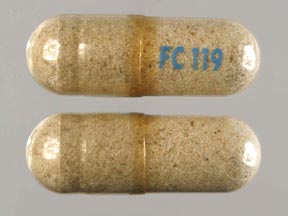Fiber Capsules Disease Interactions
There are 4 disease interactions with Fiber Capsules (psyllium).
Bulk producing laxatives (applies to Fiber Capsules) intestinal obstruction
Major Potential Hazard, High plausibility. Applicable conditions: Gastrointestinal Obstruction
The use of bulk producing laxatives is contraindicated in patients with intestinal obstruction or fecal impaction. Bulk producing laxatives can exacerbate these conditions.
Laxatives (applies to Fiber Capsules) inflammatory bowel disease
Major Potential Hazard, Moderate plausibility.
The use of laxatives is contraindicated in patients with inflammatory bowel disease. Patients with inflammatory bowel disease may experience colonic perforation with use of stimulant laxatives.
Laxatives (applies to Fiber Capsules) intestinal obstruction disorders
Major Potential Hazard, Moderate plausibility. Applicable conditions: Gastrointestinal Obstruction
The use of laxatives is contraindicated in patients with intestinal obstruction disorders. Patients with intestinal obstruction disorders may need their underlying condition treated to correct the constipation. Some laxatives require reduction in the colon to their active form to be effective which may be a problem in patients with intestinal obstruction.
Bulk producing laxatives (applies to Fiber Capsules) renal dysfunction
Moderate Potential Hazard, High plausibility.
Bulk producing laxatives require the consumption of at least 8 ounces of fluid per each dose. Patients with fluid restriction conditions such as renal dysfunction may benefit more from emollient or stimulant laxatives.
Switch to professional interaction data
Fiber Capsules drug interactions
There are 29 drug interactions with Fiber Capsules (psyllium).
Fiber Capsules alcohol/food interactions
There is 1 alcohol/food interaction with Fiber Capsules (psyllium).
More about Fiber Capsules (psyllium)
- Check interactions
- Compare alternatives
- Drug images
- Side effects
- Dosage information
- During pregnancy
- Drug class: laxatives
- Breastfeeding
Related treatment guides
Drug Interaction Classification
| Highly clinically significant. Avoid combinations; the risk of the interaction outweighs the benefit. | |
| Moderately clinically significant. Usually avoid combinations; use it only under special circumstances. | |
| Minimally clinically significant. Minimize risk; assess risk and consider an alternative drug, take steps to circumvent the interaction risk and/or institute a monitoring plan. | |
| No interaction information available. |
See also:
Further information
Always consult your healthcare provider to ensure the information displayed on this page applies to your personal circumstances.


